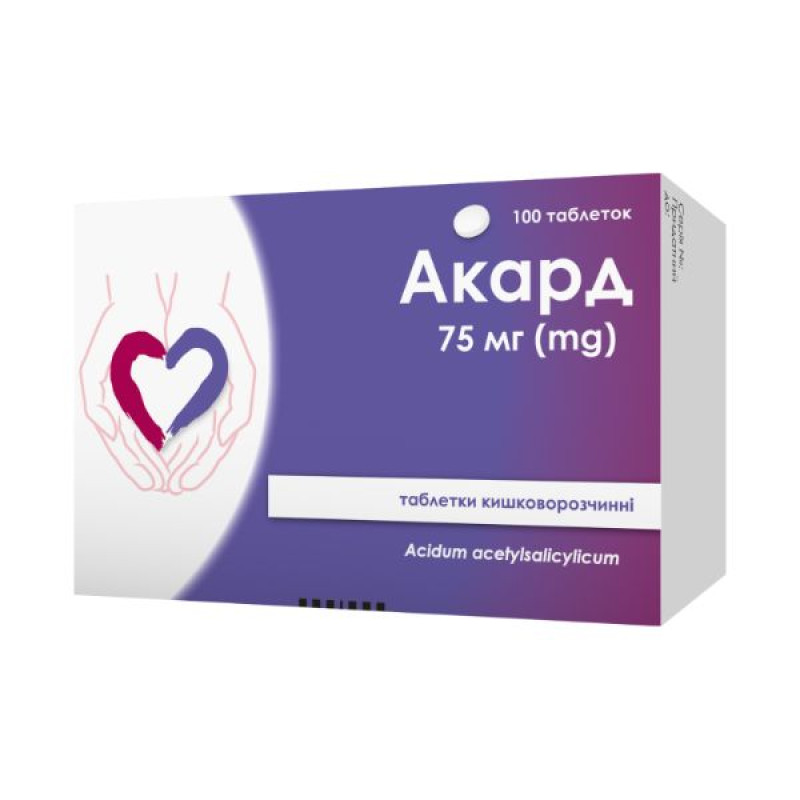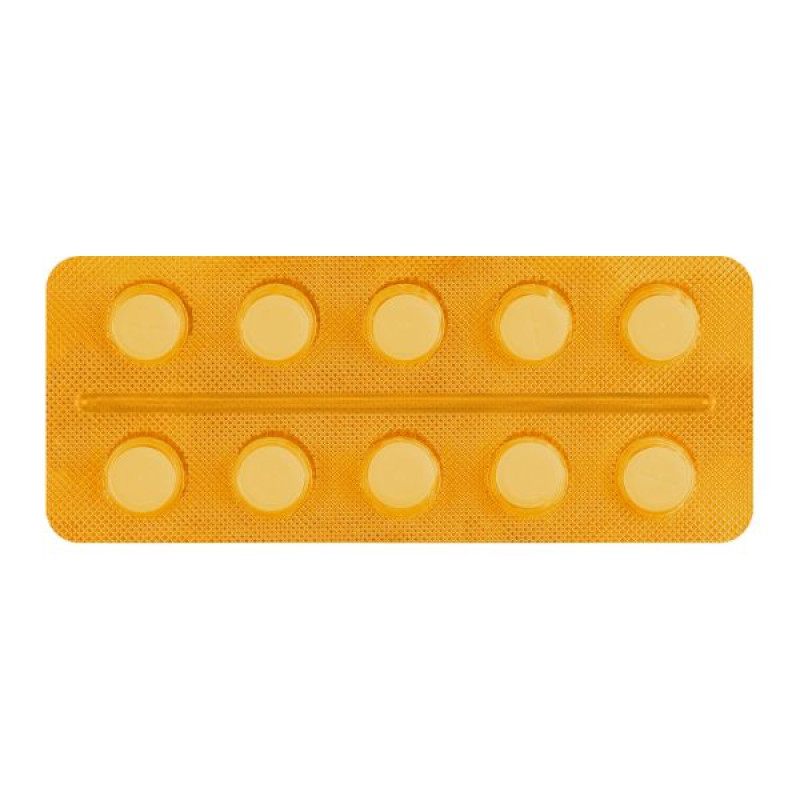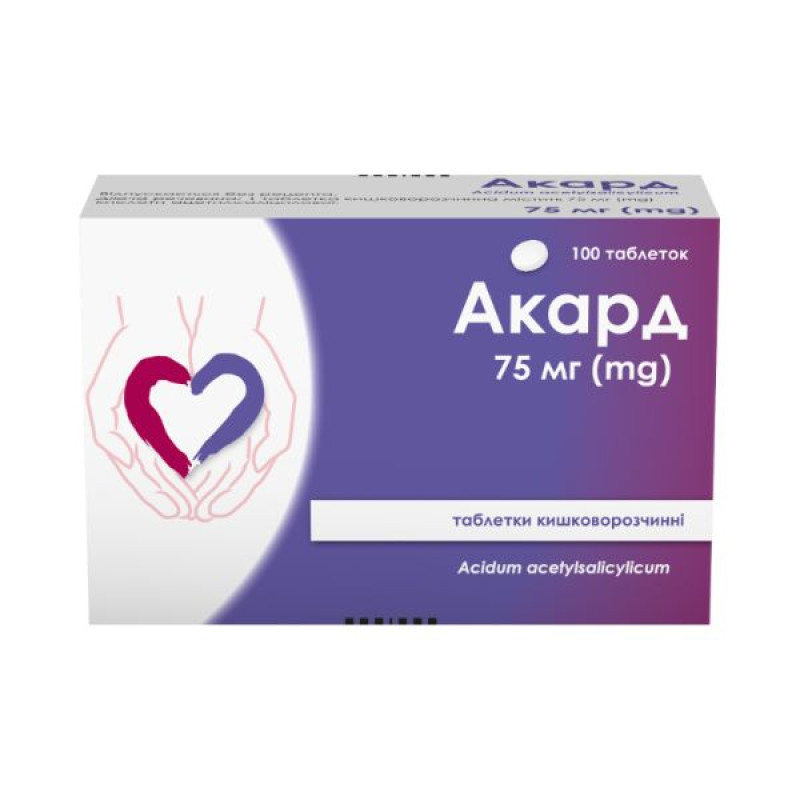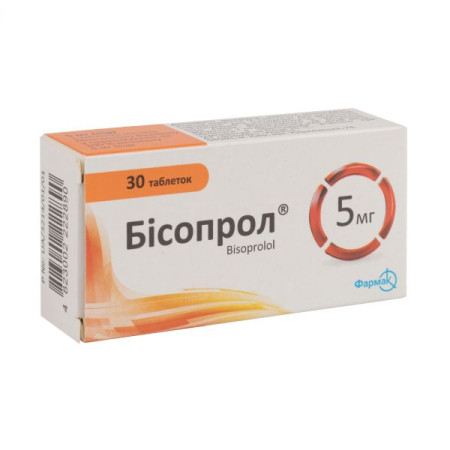Acard enteric-coated tablets 75 mg blister No. 100

Instructions for use Akard enteric-coated tablets 75 mg blister No. 100
Composition
active ingredient: Acidum acetylsalicylicum;
1 enteric-coated tablet contains 75 mg or 150 mg of acetylsalicylic acid;
excipients: corn starch, powdered cellulose, sodium starch glycolate (type A), hypromellose;
shell: triethyl citrate, methacrylate copolymer (type C), talc, titanium dioxide (E 171), sodium lauryl sulfate, colloidal anhydrous silica, sodium bicarbonate.
Dosage form
Enteric-coated tablets.
Main physicochemical properties: round, white, film-coated, biconvex tablets.
Pharmacotherapeutic group
Antithrombotic agents. Platelet aggregation inhibitors, except heparin.
ATX code B01A C06.
Pharmacological properties
Pharmacodynamics.
Acard contains an acetyl derivative of salicylic acid with antiplatelet, antipyretic, analgesic, and anti-inflammatory effects.
The mechanism of inhibition of platelet aggregation by acetylsalicylic acid consists in the irreversible inactivation in blood platelets of the enzyme cyclooxygenase-1, which transforms arachidonic acid into cyclic peroxides (PGG2 and PGH2), which are precursors of platelet prostaglandins and thromboxane (A2).
Inhibition of aggregation occurs after small doses of the drug and persists for several days after the use of a single dose.
These properties of acetylsalicylic acid have been used to prevent and treat complications associated with blood clots, as well as to prevent myocardial infarction and ischemic heart disease.
Acard enteric-coated tablets are a dosage form that does not dissolve in the stomach, which reduces the risk of direct contact of acetylsalicylic acid with the gastric mucosa. The dissolution of the tablet and the release of the active substance occur only in the more alkaline environment of the duodenum.
Absorption of acetylsalicylic acid from enteric-coated tablets is slower than from standard forms. It begins 3-6 hours after taking the drug, which indicates that the coating effectively blocks the breakdown of the drug in the stomach.
Pharmacokinetics.
The maximum concentration in blood plasma occurs after approximately 6 hours and averages 12.7 μg/ml for 150 mg tablets and 6.72 μg/ml for 75 mg tablets.
The presence of food in the gastrointestinal tract slows down the absorption of the drug, but does not reduce the bioavailability of acetylsalicylic acid.
Acetylsalicylic acid is absorbed in the gastrointestinal tract by 80-100%.
Acetylsalicylic acid is rapidly and extensively distributed in most tissues and biological fluids of the body.
The relative volume of distribution is about 0.15-0.2 l/kg and increases with increasing serum drug concentration.
About 33% of the drug is bound to plasma proteins at a concentration of 120 μg/mL.
The degree of protein binding of the drug depends on the concentration of albumin; in healthy volunteers, it decreases in proportion to the decrease in this concentration.
In renal failure, during pregnancy and in newborns, the binding of acetylsalicylic acid to plasma proteins is reduced not only due to hypoalbuminemia, but also due to the accumulation of endogenous factors that displace the drug from protein compounds.
Acetylsalicylic acid is partially biotransformed during absorption. This process occurs under the influence of esterase, mainly in the liver, but also in blood serum, erythrocytes and synovial fluid.
Salicylates are mainly combined with glycine to form salicylic acid and with glucuronic acid to form salicylic phenol and salicylic acyl glucuronate; only a small part of them undergoes hydroxylation to gentisic acid, 2,3-dihydroxybenzoic and 2,3,5-trihydroxybenzoic acids.
In women, the hydroxylation process occurs more slowly (lower esterase activity in the blood serum).
The half-life in the elimination phase of acetylsalicylic acid from plasma is about 2-3 hours.
Unlike other salicylates, unhydrolyzed acetylsalicylic acid does not accumulate in the blood serum after repeated administration.
Only about 1% of an oral dose of acetylsalicylic acid is excreted in the urine in unhydrolyzed form, the rest is excreted in the form of salicylates and their metabolites.
In patients with preserved renal function, 80-100% of a single dose of the drug is excreted in the urine within 24-72 hours.
Indication
For doses of 75 mg and 150 mg:
- Acute and chronic ischemic heart disease.
For a dose of 75 mg:
- Prevention of re-thrombosis.
- Primary prevention of thrombosis, cardiovascular diseases, such as acute coronary syndrome in patients over 50 years of age who have risk factors for the development of cardiovascular diseases: arterial hypertension, hypercholesterolemia, diabetes mellitus, obesity (body mass index > 30), hereditary history (myocardial infarction in patients under 55 years of age in at least one parent or sibling).
Contraindication
- Hypersensitivity to acetylsalicylic acid, to other salicylates or to any component of the drug.
- History of asthma induced by the use of salicylates or substances with a similar effect, especially NSAIDs.
- Acute peptic ulcers.
- Hemorrhagic diathesis.
- Severe renal failure.
- Severe liver failure.
- Severe heart failure.
- Combination with methotrexate at a dosage of 15 mg/week or more (see "Interaction with other medicinal products and other types of interactions").
Interaction with other medicinal products and other types of interactions
Contraindications for simultaneous use.
Methotrexate. The use of acetylsalicylic acid and methotrexate in doses of 15 mg/week or more increases the hematological toxicity of methotrexate (reduction in renal clearance of methotrexate by anti-inflammatory agents and displacement of methotrexate from plasma protein binding by salicylates).
ACE inhibitors. Angiotensin-converting enzyme inhibitors in combination with high doses of acetylsalicylic acid cause a decrease in glomerular filtration due to inhibition of the vasodilator effect of prostaglandins and a decrease in the antihypertensive effect.
Carbonic anhydrase inhibitors (acetazolamide). Possible reduction in acetazolamide excretion; salicylate intoxication may occur in patients receiving high doses of salicylates and carbonic anhydrase inhibitors. Concomitant use of carbonic anhydrase inhibitors such as acetazolamide and salicylates may result in severe acidosis and increased central nervous system toxicity.
Drugs that increase uric acid excretion (probenecid, sulfinpyrazone, benzbromarone). When probenecid and high doses of salicylates (> 500 mg) are used, the metabolism of each other is inhibited and the excretion of uric acid by the renal tubules may be reduced.
Combinations that should be used with caution.
Methotrexate. When using acetylsalicylic acid and methotrexate in doses less than 15 mg/week, the hematological toxicity of methotrexate increases (reduction in renal clearance of methotrexate by anti-inflammatory agents and displacement of methotrexate from plasma protein binding by salicylates).
Clopidogrel, ticlopidine. The combined use of clopidogrel and acetylsalicylic acid has a synergistic effect. Such combined use should be carried out with caution, as it increases the risk of bleeding.
Anticoagulants (warfarin, phenprocoumon). May reduce thrombin production, resulting in an indirect effect on platelet activity (vitamin K antagonist) and an increased risk of bleeding.
Abciximab, tirofiban, eptifibatide. Possible inhibition of glycoprotein IIb/IIIa receptors on platelets, leading to an increased risk of bleeding.
Heparin: May reduce thrombin production, resulting in an indirect effect on platelet activity, leading to an increased risk of bleeding.
If two or more of the above substances are used together with acetylsalicylic acid, this may lead to a synergistic effect of increased inhibition of platelet activity and, as a result, increased hemorrhagic diathesis.
NSAIDs and COX-2 inhibitors (celecoxib). Concomitant use increases the risk of gastrointestinal disorders, which may lead to gastrointestinal bleeding.
Ibuprofen: Concomitant use of ibuprofen inhibits irreversible platelet aggregation induced by acetylsalicylic acid. Treatment with ibuprofen in patients at increased risk of cardiovascular events may limit the cardioprotective effect of acetylsalicylic acid.
Patients who take acetylsalicylic acid once a day for the prevention of cardiovascular disease and occasionally take ibuprofen should take acetylsalicylic acid at least 2 hours before taking ibuprofen.
Furosemide. Simultaneous use of acetylsalicylic acid in doses of 3 g or more per day and diuretics may weaken the diuretic effect of furosemide due to sodium and water retention in the body due to a decrease in glomerular filtration caused by a decrease in prostaglandin synthesis in the kidneys. Inhibition of proximal tubular elimination of furosemide is also possible, which leads to a decrease in the diuretic effect of furosemide. Acetylsalicylic acid may enhance the ototoxic effect of furosemide.
Quinidine: May have an additive effect on platelets, leading to prolonged bleeding time.
Spironolactone: Possible modified renin effect, leading to reduced efficacy of spironolactone.
Antiepileptic drugs (valproate, phenytoin). When used simultaneously with valproate, acetylsalicylic acid displaces it from its association with plasma proteins, increasing the toxicity of the latter (central nervous system depression, gastrointestinal disorders). Valproate enhances the antiplatelet effect of acetylsalicylic acid due to the synergistic effect of these drugs. Acetylsalicylic acid enhances the effect of phenytoin.
Systemic glucocorticosteroids (excluding hydrocortisone, which is used for replacement therapy in Addison's disease) reduce the level of salicylates in the blood and increase the risk of overdose after the end of treatment.
Antidiabetic drugs (insulin, sulfonylurea derivatives). The simultaneous use of acetylsalicylic acid and antidiabetic drugs increases the risk of hypoglycemia due to the hypoglycemic properties of acetylsalicylic acid and its displacement of sulfonamides from protein compounds in the blood plasma.
Antacids. Possible increase in renal clearance and decrease in renal absorption (due to increased urine pH), which leads to a decrease in the effect of acetylsalicylic acid.
Varicella vaccine. Concomitant use increases the risk of Reye's syndrome.
Ginkgo biloba. Concomitant use with ginkgo biloba inhibits platelet aggregation, which leads to an increased risk of bleeding.
Digoxin. When used simultaneously with digoxin, the concentration of the latter in the blood plasma increases due to a decrease in renal excretion.
Alcohol contributes to damage to the gastrointestinal mucosa and prolongs bleeding time due to the synergism of acetylsalicylic acid and alcohol.
Antibacterials. Possible increase in the toxicity of sulfonamides.
Anti-nausea medications (metoclopramide) enhance the effects of acetylsalicylic acid by increasing the rate of absorption.
Leukotriene antagonists: Increased plasma concentrations of zafirlukast may occur.
Effects on thyroid function tests: Acetylsalicylic acid may affect thyroid function tests.
Aspirin may interfere with the following urine tests: catecholamines, dopa, glucose, ketone bodies, hippuric acid, homovanillic acid, 17-hydroxycorticosteroids, 5-hydroxyindoleacetic acid, urine pregnancy tests, and some plasma tests for albumin, barbiturates, calcium, propylthiouracil, tyrosine, and uric acid.
Application features
Acard should be used with caution in:
- hypersensitivity to analgesic, anti-inflammatory, antirheumatic drugs, as well as in the presence of allergies to other substances;
- gastrointestinal ulcers, including chronic and recurrent or history of gastrointestinal bleeding;
- simultaneous use of anticoagulants;
- impaired kidney and/or liver function;
- in patients with impaired renal function or in patients with cardiovascular circulatory disorders (e.g. renal vascular pathology, congestive heart failure, hypovolemia, extensive surgery, sepsis or severe bleeding), since acetylsalicylic acid may also increase the risk of impaired renal function and acute renal failure;
- in patients with severe glucose-6-phosphate dehydrogenase deficiency, acetylsalicylic acid may cause hemolysis or hemolytic anemia. Especially in the presence of factors that may increase the risk of hemolysis, such as high doses of the drug, fever or acute infectious process.
Ibuprofen may reduce the inhibitory effect of acetylsalicylic acid on platelet aggregation. In the case of using the drug Akard, the patient should consult a doctor before starting to take ibuprofen as a painkiller.
Acetylsalicylic acid may cause bronchospasm or an attack of bronchial asthma or other hypersensitivity reactions. Risk factors include a history of asthma, hay fever, nasal polyps or chronic respiratory disease, and a history of allergic reactions (e.g. skin reactions, itching, urticaria) to other substances.
Due to the inhibitory effect of acetylsalicylic acid on platelet aggregation, which persists for several days after administration, the use of drugs containing acetylsalicylic acid may increase the likelihood/increase bleeding during surgery (including minor surgical interventions, such as tooth extraction). Acetylsalicylic acid should not be used 5 days before elective surgery, in particular ophthalmic or otolaryngological.
Elderly patients are more susceptible to the toxic effects of salicylates. Continuous long-term use of aspirin should be avoided in such patients because of the increased risk of gastrointestinal bleeding.
Before starting long-term use of aspirin for the prevention of cardio and cerebrovascular diseases, it is necessary to consult a doctor to determine the benefit/risk ratio on an individual basis.
When using low doses of acetylsalicylic acid, the excretion of uric acid may be reduced. This may lead to an attack of gout in patients prone to it.
Acetylsalicylic acid-containing drugs should not be used in children with acute respiratory viral infections (ARI), with or without fever. Some viral diseases, especially influenza A, influenza B and chickenpox, carry a risk of developing Reye's syndrome, which is a very rare but life-threatening illness requiring immediate medical attention. The risk may be increased if acetylsalicylic acid is used as a concomitant medication, but a causal relationship has not been proven in this case. If these conditions are accompanied by prolonged vomiting, this may be a sign of Reye's syndrome.
Considering the above reasons, the use of the drug is contraindicated in children under 16 years of age.
Use during pregnancy and breastfeeding
Inhibition of prostaglandin synthesis may adversely affect pregnancy and/or embryonal/fetal development. Available epidemiological data indicate a risk of miscarriage and foetal malformations after the use of prostaglandin synthesis inhibitors in early pregnancy. The risk increases with increasing dose and duration of therapy. According to the available data, the association between the use of acetylsalicylic acid and an increased risk of miscarriage has not been confirmed.
The available epidemiological data on the occurrence of malformations are not consistent, but an increased risk of gastroschisis cannot be excluded with the use of acetylsalicylic acid. The results of a prospective study of exposure in early pregnancy (1-4 months) involving approximately 14,800 woman-child pairs do not indicate any association with an increased risk of malformations.
Animal studies indicate reproductive toxicity.
During the first and second trimesters of pregnancy, acetylsalicylic acid-containing drugs should not be prescribed unless clearly necessary. In women who may be pregnant or during the first and second trimesters of pregnancy, the dose of acetylsalicylic acid-containing drugs should be as low as possible and the duration of treatment should be as short as possible.
During the third trimester of pregnancy, all prostaglandin synthesis inhibitors may affect the fetus in the following ways:
- cardiopulmonary toxicity (with premature closure of the ductus arteriosus and pulmonary hypertension);
- impaired renal function with possible subsequent development of renal failure with oligohydramnios;
Prostaglandin synthesis inhibitors can affect a woman and her baby at the end of pregnancy in the following ways:
- possibility of prolongation of bleeding time, antiplatelet effect, which may occur even after very low doses;
- inhibition of uterine contractions, which can lead to a delay or prolongation of labor.
Given this, acetylsalicylic acid is contraindicated during the third trimester of pregnancy.
Salicylates and their metabolites pass into breast milk in small quantities.
Since no harmful effects on the child have been observed after administration to lactating women, it is generally not necessary to interrupt breastfeeding. However, in cases of regular use or when using high doses, breastfeeding should be discontinued early.
The ability to influence the reaction speed when driving a car and other mechanisms
Does not affect.
Method of administration and doses
Acute and chronic ischemic heart disease.
The recommended initial dose is 150 mg per day. The maintenance dose is 75 mg per day.
Acute myocardial infarction. Unstable angina.
The recommended dose is 150-450 mg, administered as soon as possible after the onset of symptoms.
Prevention of re-thrombosis.
The recommended initial dose is 150 mg per day. The maintenance dose is 75 mg per day.
Primary prevention of thrombosis, cardiovascular diseases such as acute coronary syndrome in patients with risk factors for cardiovascular disease.
The recommended preventive dose is 75 mg per day.
Swallow the tablets whole, with water if necessary. To ensure rapid absorption, the tablet can be chewed or dissolved in water.
Hepatic impairment. The drug should not be used in patients with severe hepatic impairment. Dosage adjustment may be necessary in patients with hepatic impairment.
Renal impairment: Do not use in patients with severe renal impairment (glomerular filtration rate < 0.2 mL/s (10 mL/min)). Dosage adjustment may be necessary in patients with renal impairment.
Children
The use of the drug is contraindicated in children under 16 years of age.
Overdose
Toxicity.
Dangerous dose: Adults: 300 mg/kg body weight.
Symptoms of chronic moderate poisoning (resulting from prolonged use of high doses of the drug): dizziness, vertigo, deafness, increased sweating, fever, rapid breathing, tinnitus, respiratory alkalosis, metabolic acidosis, lethargy, moderate dehydration, headache, confusion, nausea and vomiting.
Acute intoxication is indicated by a pronounced change in acid-base balance, which may vary depending on age and severity of intoxication. Its most common manifestation in children is metabolic acidosis. The severity of the condition cannot be assessed solely on the basis of the concentration of salicylates in the blood plasma. The absorption of acetylsalicylic acid may be slowed down due to delayed gastric release, the formation of concrements in the stomach or when the drug is taken in the form of enteric-coated tablets.
Symptoms of severe and acute poisoning (due to overdose): hypoglycemia (mainly in children), encephalopathy, coma, hypotension, pulmonary edema, convulsions, coagulopathy, cerebral edema, cardiac arrhythmias.
A more pronounced toxic effect is observed in patients with chronic overdose or abuse of the drug, as well as in elderly patients or children.
Treatment. In case of acute overdose, gastric lavage and administration of activated charcoal are necessary. If a dose of more than 120 mg/kg body weight is suspected, activated charcoal should be administered again.
Serum salicylate levels should be measured at least every 2 hours after dosing until salicylate levels are consistently reduced and acid-base balance is restored.
Prothrombin time and/or INR (international normalized ratio) should be checked, particularly if bleeding is suspected.
It is necessary to restore the balance of fluids and electrolytes. Effective methods of removing salicylate from the blood plasma are alkaline diuresis and hemodialysis. Hemodialysis should be used in cases of severe intoxication, as this method significantly accelerates the elimination of salicylate and restores the acid-base and water-salt balances.
Due to the complex pathophysiological effects of salicylate poisoning, signs and symptoms/test results may include:
| Manifestations and symptoms | Test results | Therapeutic measures |
| Mild or moderate intoxication | Gastric lavage, repeated administration of activated charcoal, forced alkaline diuresis | |
| Tachypnea, hyperventilation, respiratory alkalosis | Alkalemia, alkaluria | Restoration of electrolyte and acid-base balance |
| Diaphoresis (increased sweating) | ||
| Nausea, vomiting | ||
| Moderate or severe intoxication | Gastric lavage, repeated administration of activated charcoal, forced alkaline diuresis, hemodialysis in severe cases | |
| Respiratory alkalosis with compensatory metabolic acidosis | Acidemia, aciduria | Restoration of electrolyte and acid-base balance |
| Hyperpyrexia | Restoration of electrolyte and acid-base balance | |
| Respiratory: hyperventilation, noncardiogenic pulmonary edema, respiratory failure, asphyxia | ||
| Cardiovascular: dysarrhythmias, hypotension, cardiovascular failure | For example, changes in blood pressure, ECG | |
| Fluid and electrolyte loss: dehydration, oliguria, renal failure | For example, hypokalemia, hypernatremia, hyponatremia, changes in renal function | Restoration of electrolyte and acid-base balance |
| Impaired glucose metabolism, ketoacidosis | Hyperglycemia, hypoglycemia (especially in children). Elevated ketone bodies | |
| Ringing in the ears, deafness | ||
| Gastrointestinal bleeding from the gastrointestinal tract | ||
| Hematologic: platelet inhibition, coagulopathy | For example, PT prolongation, hypoprothrombinemia |
Adverse reactions
The information on adverse reactions presented is based on spontaneous post-marketing reports of adverse reactions with all dosage forms and strengths of acetylsalicylic acid (including oral administration during short and long-term treatment). Therefore, classification of adverse reactions according to CIOMS III frequency categories has not been performed.
Circulatory and lymphatic system disorders: bleeding (intraoperative hemorrhages, hematomas, bleeding or increased duration from the genitourinary system, epistaxis, bleeding from the gums. Symptoms may persist for 4-8 days after discontinuation of acetylsalicylic acid. As a result, there is an increased risk of bleeding during surgical interventions. Existing hematemesis, melena or occult gastrointestinal bleeding may lead to iron deficiency anemia (more often when using high doses). Rarely or very rarely - serious bleeding, such as gastrointestinal hemorrhage, cerebral hemorrhage (especially in patients with uncontrolled hypertension and/or concomitant use of anticoagulants), which in isolated cases can be potentially life-threatening.
Thrombocytopenia, granulocytosis, leukopenia, agranulocytosis or eosinopenia, anemia (posthemorrhagic/iron deficiency) with corresponding laboratory parameters and clinical manifestations, including: asthenia, pallor of the skin, hypoperfusion; hemolysis and hemolytic anemia (in patients with severe forms of glucose-6-phosphate dehydrogenase deficiency).
Immune system: Hypersensitivity reactions with corresponding laboratory and clinical manifestations include asthmatic status, mild to moderate skin reactions, as well as reactions from the respiratory system, gastrointestinal tract and cardiovascular system, including symptoms such as rash, urticaria, edema, itching, rhinitis, nasal congestion, cardiorespiratory failure and very rarely severe reactions, including anaphylactic shock. In patients with bronchial asthma, an increased frequency of bronchospasm; allergic reactions of mild to moderate severity, potentially affecting the skin, respiratory tract, gastrointestinal tract and cardiovascular system, may occur.
Skin and subcutaneous tissue disorders: Stevens-Johnson syndrome, Lyell's syndrome, hemorrhagic rashes, erythema nodosum, erythema multiforme.
Renal and urinary disorders: renal dysfunction, acute renal failure, urogenital bleeding. After prolonged use of high doses of acetylsalicylic acid, papillonecrosis and interstitial nephritis may occur. Proteinuria, leukocyturia, erythrocyturia and renal calculi.
From the nervous system: headache, dizziness, disorientation.
On the part of the auditory organs: hearing impairment, ringing in the ears (tinnitus), which may indicate an overdose.
Cardiovascular system: heart failure, hematomas, arterial hypertension.
Respiratory system: nosebleed.
Hepatobiliary disorders: transient hepatic failure, increased levels of hepatic transaminases, alkaline phosphatase and bilirubin concentration. Focal necrosis of hepatocytes, pain in the liver area and hypertrophy may occur in patients with juvenile rheumatoid arthritis, systemic lupus erythematosus, rheumatism or a history of liver disease.
Metabolic disorders: hypoglycemia, hyperuricemia with corresponding laboratory parameters and clinical manifestations (gout attacks).
Expiration date
2 years.
Do not use after the expiration date.
Storage conditions
Store in the original packaging at a temperature not exceeding 25 ºC.
Keep out of reach of children.
Packaging
10 tablets in a blister; 5 blisters in a cardboard box.
Vacation category
Without a prescription.
Producer
Pharmaceutical Plant "POLPHARMA" S.A.
Pharmaceutical Works "POLPHARMA" SA
Location of the manufacturer and its business address
19 Pelplinski Street, 83-200, Starogard Gdański, Poland
19, Pelplinska Str., 83-200 Starogard Gdanski, Poland.
There are no reviews for this product.
There are no reviews for this product, be the first to leave your review.
No questions about this product, be the first and ask your question.









